AI is helping businesses of all kinds to increase revenue, reduce costs and reduce risk. AI solutions currently power critical business processes in media and entertainment, retail and e-commerce, travel and transportation, manufacturing, and more. Over 3.2 billion photos and 720,000 hours of video are created and shared on the Internet daily, along with countless text and audio passages.
Powered by deep learning and neural networks, AI systems can build “models” that help automate analysis and decision-making in business. AI models can deliver analytics smarter and faster than their human counterparts in many cases, and since AI models are just a special type of computer program, they can scale alongside ever-increasing amounts of data in the cloud.
AI models can be custom-built for specific applications, but in many cases, businesses use models that are pre-built and ready to be used right out of the box. Clarifai Community provides an amazing resource for anyone who wants access to these pre-built resources, by providing the world’s best AI models all in one place. Let's take a looks at some of the most popular AI models in the enterprise today.
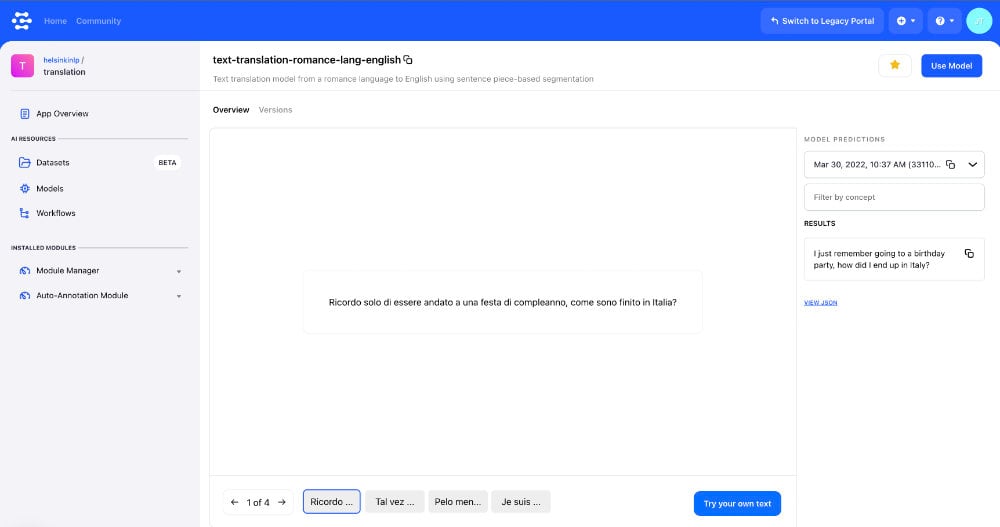 Governments, technology companies, healthcare providers, financial institutions, law firms, e-commerce companies, and more need to transmit information quickly to large numbers of people. Many of these organizations operate in multiple countries, and the languages and language skills of employees can vary a lot, not to mention the fact that people typically prefer to communicate in their native language.
Governments, technology companies, healthcare providers, financial institutions, law firms, e-commerce companies, and more need to transmit information quickly to large numbers of people. Many of these organizations operate in multiple countries, and the languages and language skills of employees can vary a lot, not to mention the fact that people typically prefer to communicate in their native language.
AI can help make businesses more efficient by decreasing or eliminating language barriers in communication. Our AI-powered “Romance Language” model can easily translate text in seconds. It can accurately translate French, Spanish, Portuguese, and Italian to English so that text translations can be obtained quickly and enable readers to understand the core content of a message. Just input text in one romance language and get a response in English.
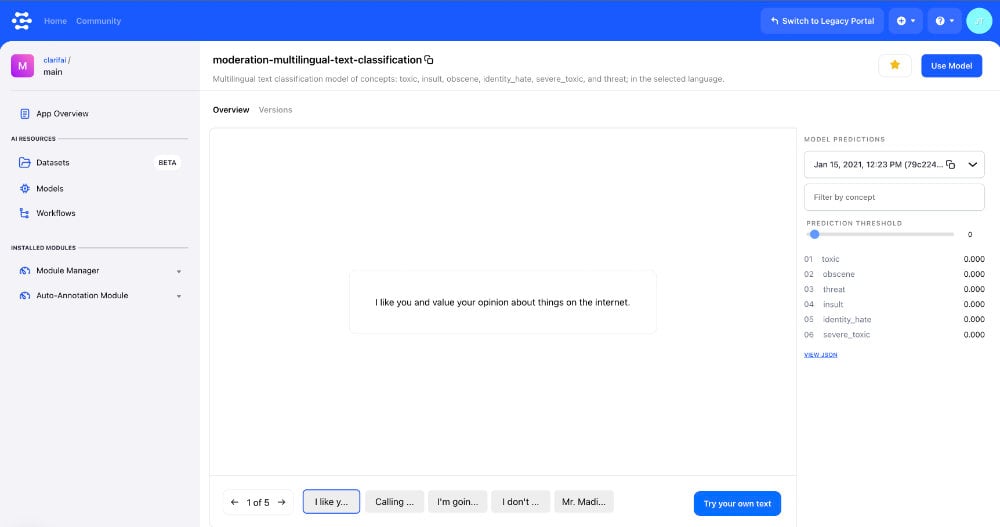 Over 50 million people in the United States alone speak languages other than English, and user-generated content (UGC) is frequently produced in languages such as Spanish, Chinese, Tagalog, Vietnamese, Arabic, French, Korean and more. This UGC is extremely valuable, but it comes with risks. If you are going to detect and prevent toxic and harmful content from being promoted by your business, you will need a content moderation solution that understands these languages.
Over 50 million people in the United States alone speak languages other than English, and user-generated content (UGC) is frequently produced in languages such as Spanish, Chinese, Tagalog, Vietnamese, Arabic, French, Korean and more. This UGC is extremely valuable, but it comes with risks. If you are going to detect and prevent toxic and harmful content from being promoted by your business, you will need a content moderation solution that understands these languages.
Our Text moderation model supports text moderation in 54 languages and returns a list of concepts: “toxic”, “insult”, “obscene”, “identity_hate”, “severe_toxic”, and “threat”. These concepts can be used to tag your data, trigger alerts, and prevent unwanted content from ever seeing the light of day.
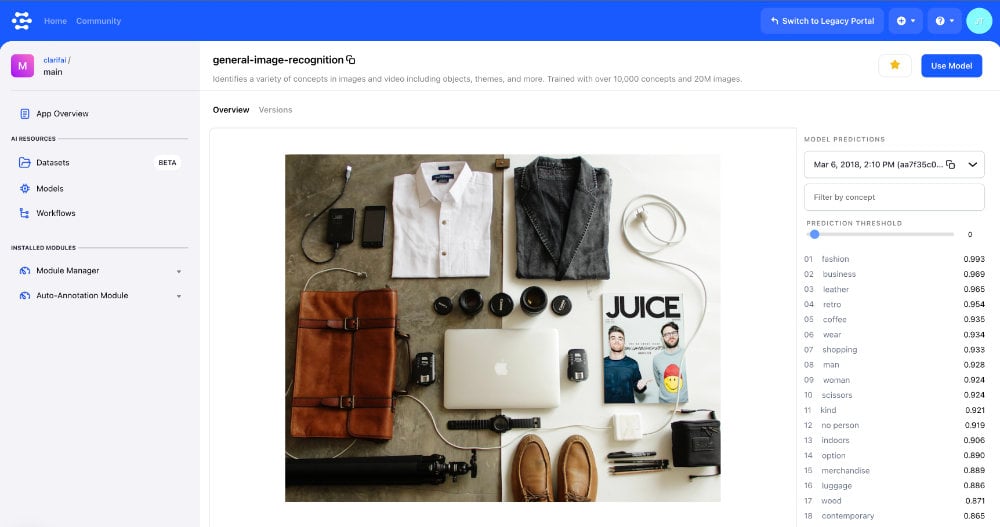 This is the latest version of the model that started it all. Clarifai’s famous “General” model is an image recognition model that identifies a variety of concepts in images and videos including objects, themes, and more. Trained with over 10,000 concepts and 20M images, the Clarifai general model offers industry-leading performance and reliability.
This is the latest version of the model that started it all. Clarifai’s famous “General” model is an image recognition model that identifies a variety of concepts in images and videos including objects, themes, and more. Trained with over 10,000 concepts and 20M images, the Clarifai general model offers industry-leading performance and reliability.
The General model has been used by companies in nearly every sector of the economy because it can help companies search sort and filter visual data of almost any kind. The general model is at the heart of digital asset management, content moderation, product organization and recommendations engines, visual inspection technology, pubic sector technology, and more. Organizations use the general model to automatically tag their data, filter out unwanted noise and prepare data for further analysis.
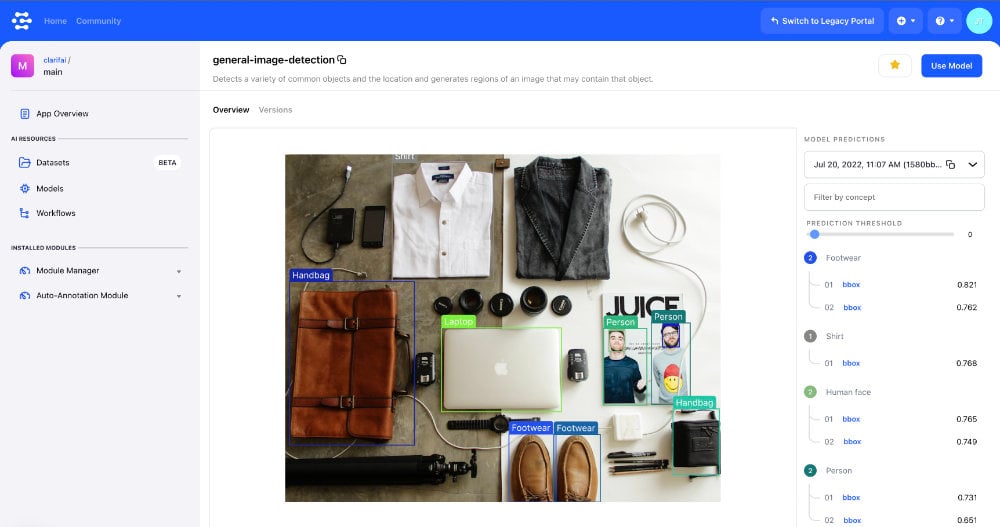 “Where is it”? This is the basic question that business operators seek to answer with the General Detector. If the General Image Recognition model that we mentioned above helps us understand “what” an image is, then the General Detector helps us understand “where” an object is in an image. The General Detector identifies common objects and their location and then draws a bounding box around the object.
“Where is it”? This is the basic question that business operators seek to answer with the General Detector. If the General Image Recognition model that we mentioned above helps us understand “what” an image is, then the General Detector helps us understand “where” an object is in an image. The General Detector identifies common objects and their location and then draws a bounding box around the object.
Object detection helps businesses to accurately detect, classify and recognize common objects from image or video feeds. Object detection is often combined with other computer vision techniques to develop applications that solve complex problems with visual data. Object detection use cases often have objectives like locating, tracking, and counting objects or detecting anomalies and outliers in an environment. Object detection data provides valuable business information that allows stakeholders to respond to events in real-time.
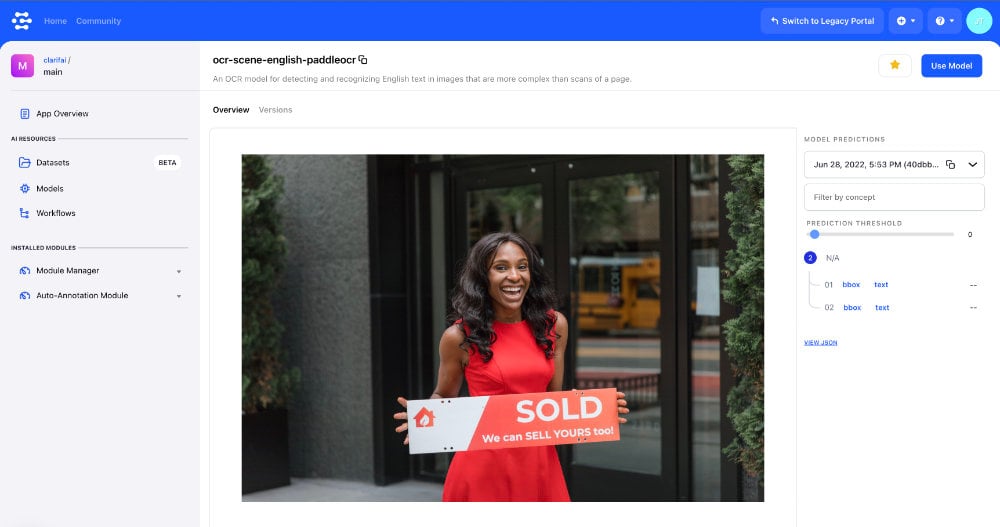 OCR, or “Object Character Recognition” models are models that are specifically designed to recognize text in images. One common use for OCR technology is to reduce costs by automatically identifying and extracting text data from documents and forms. Customers might take a photo of a paper receipt with their phone, and automatically upload the image to create a new claim using a mobile expense app. The processing of health records, legal documents, and more can be accelerated with OCR technology.
OCR, or “Object Character Recognition” models are models that are specifically designed to recognize text in images. One common use for OCR technology is to reduce costs by automatically identifying and extracting text data from documents and forms. Customers might take a photo of a paper receipt with their phone, and automatically upload the image to create a new claim using a mobile expense app. The processing of health records, legal documents, and more can be accelerated with OCR technology.
OCR is also essential when trying to understand the full context of social media content and other types of image-based communications. If there is text in an image, you will need to understand what it says if you want to understand the full meaning and context of what is being communicated. PaddleOCR provides a robust, multilingual system for detecting and recognizing text in images.
If you work with large amounts of unstructured data, you can transform this data into new revenue streams, cost reductions, and reduce risk. AI technology helps make sense of these massive streams of unstructured data by automatically tagging, sorting, filtering, and evaluating data. Clarifai Community is a game changer for anyone looking to bring the power of AI models to the enterprise. But Clarifai Community is more than just a place to find great models. You can deploy them to your applications, modify them, and analyze your data all in one easy-to-use tool. Take a look at the amazing models available through Clarifai Community and try them yourself.
© 2023 Clarifai, Inc. Terms of Service Content TakedownPrivacy Policy






© 2023 Clarifai, Inc. Terms of Service Content TakedownPrivacy Policy